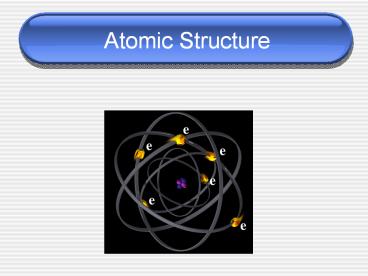Atomic Structure - PowerPoint PPT Presentation
Title:
Atomic Structure
Description:
Atomic Structure Early Theories of Matter Science as we know it did not exist several thousand years ago Democritus (460-370 BC) Democritus Theory Matter is ... – PowerPoint PPT presentation
Number of Views:282
Avg rating:3.0/5.0
Title: Atomic Structure
1
Atomic Structure
2
Early Theories of Matter
- Science as we know it did not exist several
thousand years ago
3
Democritus (460-370 BC)
4
Democritus Theory
- Matter is composed of ____________ through which
atoms move - Atoms are solid, ____________ , indestructible,
and indivisible - Different atoms have different ____________ and
____________ - The differing properties of matter are due to the
size, shape, and movement of ____________ - Changes in matter result from changes in the
____________ of atoms and not the atoms themselves
5
John Dalton
- John Dalton was the next scientist to propose a
theory about the atom in the 19th century
6
Daltons Atomic Theory
- All matter is composed of extremely small
particles called ____________ - All atoms of a given element are ____________ ,
having the same size, mass, and chemical
properties. Atoms of a specific element are
____________ from other elements - Atoms cannot be ____________ , ____________ , or
____________ - Different atoms combine in simple whole number
____________ to form compounds - In a ____________ , atoms are separated,
combined, or rearranged
7
Basic Definitions
- ____________ smallest unit of an element that
retains the properties of that element - Atoms are made up of several ____________
particles called ____________ , ____________ ,
and ____________
8
Protons, Neutrons, Electrons
- ____________ have a ____________ charge and are
found in the nucleus of the atom - ____________ have ____________ charge and are
also found in the nucleus of an atom - ____________ have a ____________ charge and are
found on the outside of the nucleus - ____________ made up of protons and neutrons,
has an overall ____________ charge
9
Atomic Structure
10
JJ Thomson
- JJ Thomson used the ____________ experiment to
determine the ____________ to ____________ ratio
of an electron. - He identified the first subatomic particle, the
____________ - He proposed the ____________ model of the atom
- Credited for discovering the ____________
11
Robert Millikan
- Millikan is noted for his famous Millikans
____________ - This experiment determined the ____________ and
the ____________ of an electron
12
Earnest Rutherford
- Rutherfords ____________ Experiment helped to
determine the existence of the ____________ - Rutherford proposed that the nucleus was
____________ , ____________ and ____________
charged - Proposed the ____________ model which stated that
there was a nucleus with a positive charge and
electrons around the outside
13
James Chadwick
- Chadwick showed that the nucleus also contained
____________ - He is credited for the discovery of the
____________
14
Atomic Numbers
- The ____________ of an element is the number of
____________ in the nucleus of an atom of that
element. - It is the number of ____________ that determines
the identity of an element. - The number of protons for an element ____________
be changed.
15
Atomic Numbers
- Because atoms are neutral, the number of
____________ must equal the number of
____________. - So, the atomic number of an element also tells
the number of ____________ in a neutral atom of
that element. - The number of ____________ can be changed when
determining the charge of an ____________ .
16
Masses
- The mass of a ____________ is almost the same as
the mass of a ____________ . - The sum of the protons and neutrons in the
nucleus is the ____________ of that particular
atom. - ____________ have different numbers of neutrons,
but they all have the same number of protons
electrons
17
Isotopes
- When writing isotopes, the ____________ (or
number of protons) will appear at the
____________ of the formula - The ____________ (number of protons plus neutrons
will appear at the ____________ of the formula. - The ____________ will appear to the ____________
of the numbers - NOTE The different number of neutrons has NO
bearing on chemical reactivity
18
Writing the Names of Isotopes
- When writing the name of an isotope, you will
write the name of the ____________ the
____________ - For example 126 C would be named
19
Try the following
Name Symbol Protons Neutrons Electrons Mass
Carbon 11
197 Au 79
1 2
25 55
Oxygen - 15
20
Atomic Mass
- ____________the weighted ____________ mass of
all the naturally occurring isotopes of that
element. - The number is usually located at the ____________
of the periodic table and has decimal places
21
Calculating Atomic Mass
22
Try this one
- Calculate the atomic mass of germanium.
23
You can tell many things from an isotope formula
- Hydrogen has three naturally occurring isotopes
in nature Hydrogen 1, Hydrogen 2, and
Hydrogen 3. - Which is the most abundant in nature?
- ____________
- Which is the heaviest?
- ____________































